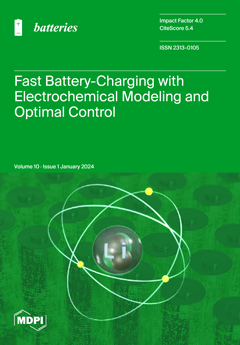Recently, potassium-ion batteries (KIBs) have attracted significant interest due to a number of factors, including the growing demand for energy and limited lithium resources. However, their practical use is hampered by poor cycling stability due to the large size of K
+.
[...] Read more.
Recently, potassium-ion batteries (KIBs) have attracted significant interest due to a number of factors, including the growing demand for energy and limited lithium resources. However, their practical use is hampered by poor cycling stability due to the large size of K
+. Therefore, it is critical to develop a structural design that effectively suppresses large volume changes. This study presents a simple method of using a salt template to fabricate porous microspheres (p-MoSe
2@C MS) of MoSe
2 and a carbon matrix as anode materials in KIBs. These microspheres have a distinct porous design, with uniformly distributed MoSe
2 nanocrystals embedded in the carbon matrix to prevent MoSe
2 overgrowth due to material diffusion during heat treatment. The manufacturing process combined one-step spray drying with recyclable NaCl as a hard template. Through a two-step thermal process under an inert atmosphere, the initial dextrin, NaCl, and Mo salt microspheres were converted into a p-MoSe
2@N MS composite. The carbon structure derived from the dextrin maintained the shape of the microspheres when NaCl was removed, ensuring no overgrowth of MoSe
2. This well-designed porous structure improves the interaction with the electrolyte, facilitating the transport of ions and electrons and reducing the K
+ diffusion distances. In addition, the porous carbon structure accommodates large volume changes during cycling and maintains its structural strength. As a result, p-MoSe
2@C MS composite exhibits superior electrochemical properties, with remarkable capacity, long-term cycling stability (193 mA h g
−1 after 500 cycles at 2.0 A g
−1), and rate capability.
Full article





